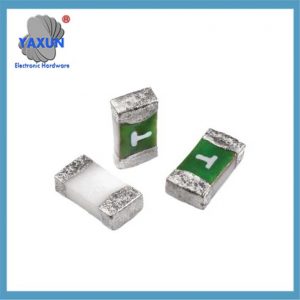Основните разлики помеѓу осигурувачите со брзо и бавно дејство лежат во нивната брзина на одговор и сценарија за примена: осигурувачите со брзо дејство дуваат веднаш за да ги заштитат чувствителните компоненти, додека осигурувачите со бавно дејство го одложуваат дувањето за да издржат пренапонски струи.
Analysis of the Main Differences
Blowing Characteristics and Response Speed.
Fast-Acting Fuses:
They have extremely fast response times, blowing within milliseconds (typically 0.1ms-5s) when overcurrent occurs. They are suitable for protecting precision electronic components such as IC chips and semiconductor devices. (UL standard).
They follow the Joule heating effect (Q = I²Rt), have a simple fuse design, and use narrow-section metal wire for rapid heat conduction.
They are sensitive to instantaneous currents and cannot withstand surge currents during power on/off or motor startup.
Slow-Acting Fuses:
They withstand short-term overcurrents (e.g., 7 times the rated current for 0.5-3 seconds during motor startup).
It features a time-delay function, taking 5 до 10 seconds to fuse at 2 пати поголема од номиналната струја, and can withstand short-term high-current surges (such as motor starting currents up to 7 пати поголема од номиналната струја).
It has a high melting heat value, achieving delayed fuse opening through heat absorption in quartz sand or a spiral design.
Fast-blow applications:
Resistive load circuits (електрични апарати за греење, LED lighting);
Protection of sensitive semiconductor devices (such as MOSFETs and lithium battery packs for short-circuit protection);
Resistive loads (електрични котлиња, шпорети за ориз);
Protection of sensitive circuits such as lithium battery packs and circuit boards;
Applications requiring rapid interruption of short-circuit currents.
Slow-blow applications:
Inductive/capacitive loads (мотори, прекинувачки напојувања);
Applications requiring surge protection (such as magnetizing surge protection for transformers over 100kVA);
Inductive/capacitive circuits such as motors, напојувања, and inverters;
Equipment subject to startup inrush current (such as switching power supplies and transformers);
Environmental environments requiring pulse current tolerance.
Protection function differences Fast-blow fuses: Provide short-circuit protection only and cannot distinguish between overload and transient pulses.
Slow-blow fuses: Provide both overload and short-circuit protection, using the I²t value (the integral of the square of the current and the time) to determine energy.
Key Parameters and Selection Key Points
I-T Curve Differences
Fast-blow fuses have a steeper curve, with a melting time of ≤0.1s at 2x the rated current; slow-blow fuses have a flatter curve, with a withstand time of ≥10s at 2x the rated current.
Interchange Risk
Replacing a slow-blow fuse with a fast-blow fuse may cause the device to fail to start; replacing a fast-blow fuse with a slow-blow fuse may increase the risk of damage to sensitive components.
Cost and Structure
Slow-blow fuses are more expensive due to their special alloys or complex structures.
Selection Considerations
Parameter Calculation Priority:
Verify that the I²t value of the circuit’s maximum surge is less than the fuse’s withstand value (на пример, a power supply must pass a 15A/150ms surge test).
The interrupting capacity must be higher than the system’s maximum short-circuit current (e.g., for a 35kA short-circuit, choose a 50kA interrupting capacity).
Common Misconceptions:
High temperatures can cause the rated current of a slow-blow fuse to drop by 30%.
Misusing a fast-blow fuse in a UPS can cause false tripping (one case resulted in losses of 1.8 million yuan).
Experiments show that when a lithium battery short-circuits, the probability of thermal runaway caused by a slow-blow fuse is eight times higher than that of a fast-blow fuse.
In inverter testing, misusing a slow-blow fuse can increase the module damage rate from 1% до 37%.
 English
English Afrikaans
Afrikaans العربية
العربية বাংলা
বাংলা bosanski jezik
bosanski jezik Български
Български Català
Català 粤语
粤语 中文(简体)
中文(简体) 中文(漢字)
中文(漢字) Hrvatski
Hrvatski Čeština
Čeština Nederlands
Nederlands Eesti keel
Eesti keel Suomi
Suomi Français
Français Deutsch
Deutsch Ελληνικά
Ελληνικά हिन्दी; हिंदी
हिन्दी; हिंदी Magyar
Magyar Bahasa Indonesia
Bahasa Indonesia Italiano
Italiano 日本語
日本語 한국어
한국어 Latviešu valoda
Latviešu valoda Lietuvių kalba
Lietuvių kalba македонски јазик
македонски јазик Bahasa Melayu
Bahasa Melayu Norsk
Norsk پارسی
پارسی Polski
Polski Português
Português Română
Română Русский
Русский Cрпски језик
Cрпски језик Slovenčina
Slovenčina Slovenščina
Slovenščina Español
Español Svenska
Svenska ภาษาไทย
ภาษาไทย Türkçe
Türkçe Українська
Українська اردو
اردو Tiếng Việt
Tiếng Việt



